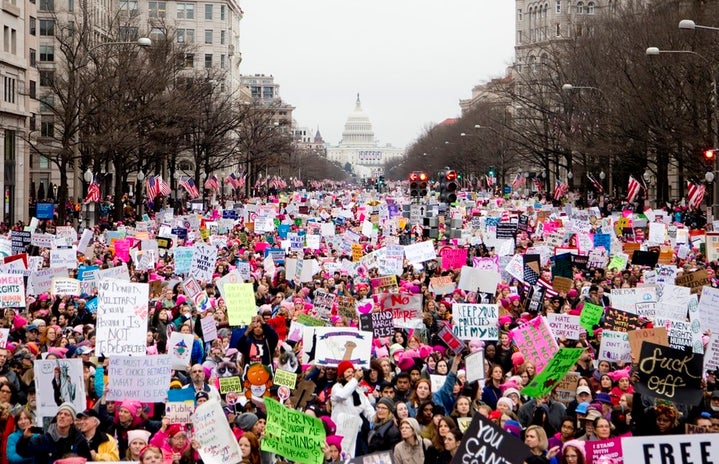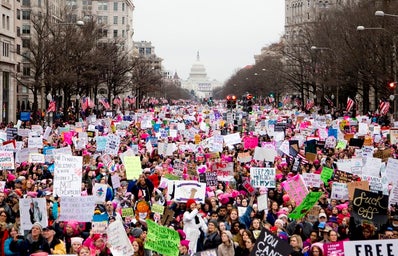As Women’s History Month has come and gone, I thought it prudent to take a look at the feminist movement as a whole. Many things that women take for granted today were hard-won victories of the past, and many things that feminism is now known for would likely horrify our foremothers. To be as accurate as possible, I interviewed two professors at Texas A&M to get the full story on the Four Waves of feminism and feminism expressed on social media. To start, I figured it would be best to discuss the history of the movement.
the Four waves
The term “feminism” was coined in 1837 by Charles Fourier, a French philosopher, and initially only referred to “feminine qualities or character.” It was later adopted by those of the movement, who sought to define it as a movement demanding equality of the sexes. Thus bred the first wave of feminism, marked by the Seneca Falls Convention in 1847 and characterized best by the fight for suffrage. This initial wave featured all the beloved figures: Sojourner Truth, Elizabeth Cady Stanton, Lucretia Mott, et cetera.
The second wave of feminism cropped up a century later, in the 1960s, and was known best for pushing the Equal Rights Amendment, which has still yet to be approved and enshrined in the Constitution. This wave, while generally overshadowed by the Black Power Movement and the Vietnam war, made great strides ahead of the first wave, in that it oversaw the creation of women-only spaces and espoused inclusivity, finally welcoming women of color into the fold. Lucretia Mott, of the first wave, was an outlier among her advocate peers in that she was one of the welcoming types, whereas figures like Stanton and Susan B. Anthony were far more focused on middle-class, white women, and generally ignored or were outright hostile to minority women.
Third wave feminism, the one many women nowadays align best with, leapt away from traditional values. Sparked in the 1990s, this wave’s followers were immediately recognizable, as they proudly donned lipstick, high heels, and low-cut clothing; “war paint,” we might call it now. It was largely superficial, with loud voices and louder looks, but held little substance and few clear goals, unlike the previous waves.
Fourth wave feminism, which is largely considered to be the one ongoing today, is still generally undefined. It is known best for a focus on empowerment of women and creating safe, supportive spaces for women to share their experiences, as well as internet advocacy. These, as well as an emphasis on intersectionality and equal opportunities, make up the kinder side of the movement. Unfortunately, as I’m sure everyone is aware, there are some much more vindictive people within the movement, ones who have corroded the good name of feminism.
Key Groups
For the sake of civil argument and open discussion, each group listed here will first be presented how they wish to be, with their arguments taken seriously. Only then will I discuss their impact on the movement.
- Trans-Exclusionary Radical Feminists
Trans-Exclusionary Radical Feminists, or “TERFs,” are probably the most well-known of these sub-groups. They believe that trans women are not truly women, because they were not raised female and thus could never truly understand the struggles of women. A woman who only became a woman at the age of sixteen has not lived through receiving safety whistles three Christmases in a row, after all.
While this idea does make some level of sense (but certainly does not apply to those who transitioned young and largely grew up as girls becoming women, like 11-year-old Texan activist Kai Shappley), TERFs go a few steps further: they maintain that trans women are not women at all, oppose transgender rights legislation, and reject the inclusion of trans women in women-only spaces. Not only is this cruel to trans women (and trans men, as it rejects their identities by proxy), it also alienates many supporters of the movement. Trans women seeking support among their sisters, cis men who recognize systemic problems and seek to aid in their change, and even cis women who are appalled at this behavior begin to distance themselves from the term “feminist” as its meaning shifts to accommodate the TERFs who proudly use it. This impact is widespread, and is seen in many other sub-groups, as well.
- Separatists
Another form of radical feminist, Separatists believe that women cannot and will not be safe and free until men are entirely removed from their lives. They are firm believers in women-only spaces, and stake their beliefs on the idea that men are a danger to women, and thus women will always be in danger if there are men around to hurt them. This sort of belief, on a much smaller scale, is not uncommon, especially among survivors of abuse or assault. Similarly, someone who nearly died from a dog bite to the skull would be utterly petrified of dogs, and avoid them religiously.
However, this belief rests on the idea that men are not capable of change. It relies on this, this belief that men cannot be taught to be more respectful, more aware. While it is true that there is always an inherent level of danger, this is true for all of life. Living in fear because there is a chance of danger is not living, it is surviving, and moving all people so that no woman ever interacts with a man is, frankly, unrealistic. Yet again, Separatists alienate the men who are respectful, who are kind and aware and determined to change things for the better, and that is devastating.
- Misandrists
Misandry is a rarely-known word. Misandrists rarely associate with it, and rarely label themselves misandrists at all. Misandry, simply put, is misogyny flipped on its head; it is the belief that women are inherently superior to men. Nearly all misandrists hide behind the guise of a feminist, and many do not even realize that they are not what they claim to be. They, like Separatists, believe men are more dangerous, less kind, and sometimes even less intelligent than women.
Unfortunately, they are some of the loudest voices within the feminist movement, decrying the very real issues men face, encouraging their harm and deaths, and insulting them at every opportunity. This behavior is far from the “equality of the sexes” that the founders of this movement fought for. It is far from the peaceful protests, the sit-ins, and the boycotts revered as the golden standard of pushing change. It is a cruelty entirely new to this movement, wholly owned by this wave.
Women Talking (2022)
I grew up in a loving home, in a safe area, with few experiences to make me fear the world, and I still find myself full of white-hot rage on some days, simply for the life I and other women have been subjected to. The film Women Talking, based on the 2018 novel and a true story, is the worst-case scenario. Women of all ages in an insular community, unable to read or write or defend themselves, systematically abused for years.
And these women, even after everything they went through, are kind. They welcome a soft-spoken man, August (played by Ben Whishaw), to take the minutes of their meeting, and ask his opinion on the nature of the young boys. They question whether the young men, even those who hurt them, were ever taught that what they did was wrong, and if, then, they are just as much victims of the community as themselves. Even the most furious of them, Salome (played by Claire Foy), who went after one of the men with a sickle for hurting her daughter, is kind to August, encouraging him to have hope for the young men, to teach them to be better when the women cannot.
For women of my ilk – women in good situations, women who are safe and loved and have never felt the pain so many less fortunate women have – to be cruel, to be hateful, and to openly and loudly wish for the death of every man, whether or not he is a bad one, as if every man is inherently some monstrous being, is not in the least what our foremothers wanted for us. Stanton, Mott, Truth; they sought kindness, compassion, respect. They sought equality. They did not seek revenge. It truly pains me to see such violence and savagery heralded as what women should strive for.
Radicalization
Radicalization is something we are facing as a whole in the modern era, heavily pushed by social media. Far too often now, the art of civil discussion is visibly degraded. When someone says something we dislike on the Internet, so many of us simply block them rather than discuss with them. This simultaneously destroys the possibility of teaching them better and encourages them to think they were right, since we backed down from the fight as though we had no argument to their claim. The 2020 documentary The Social Dilemma goes into more depth on this, but I will summarize some of the key points.
- Anonymity
Anonymity is a double-edged sword. While it does give some the ability to truly be themselves (Ex. LGBTQ+ kids who have yet to come out), it also gives people with truly poisonous inner desires to spew them out without repute. This brings those awful parts of themselves to the forefront, and the more they use that side of themselves, the more comfortable they are with it. This allows people to feel more and more like being that way is normal, or acceptable, and children who are on social media with them absorb that rhetoric, as well.
- No consequences
When someone says something awful to a screen, it is so different from saying it to someone’s face. I’ve seen this phrased as: “We need the threat of being punched in the face. People don’t necessarily need to be punched, but it needs to be possible.” In essence, when we have no consequences for what we say – whether that be seeing the effect on someone or, in the worst case, physical pain from their reaction – we are much more likely to speak without considering the effect. This tends to have the same effect as anonymity, giving people the peace of mind to say whatever they wish, and then feeling the effects of that.
- Feedback loop
Social media – and this should not be a surprise – shows you what you want to see. If you like a picture of a dog, it will show you more dog pictures. If you like something political, it will show you more political things for that side. Do this enough, and you will be flooded with that side’s opinions. This radicalizes people on both sides of the spectrum, and I experienced this myself with Pinterest. Fortunately, I hit a wall, where the extremely radical posts I was seeing shocked me, and eventually it was harming my mental state so much that I deleted Pinterest altogether. This means that someone who may have started out very moderate will potentially become one of the groups I mentioned above, not necessarily by their own choice, but because they have been inundated with those opinions. The frog has been boiled, and now the frog thinks all men should be shipped to another continent.
Social Media
Women flock to social media to share their experiences, and this is completely understandable. They are able to speak to people like them from across the globe, and for women in bad situations, that is invaluable. However, I would argue it’s not all good advice.
One of the notable trends that has appeared on social medias is the simple statement, “Men are trash.” I spoke with Dr. Lucy Miller about this, a faculty member in the Department of Communication & Journalism at Texas A&M University, and she believes that those who say it are using this hyperbole “as a reminder to herself that she is not at fault for the bad behavior of some of the men in her life.” While I agree that many women use this as hyperbole and are using it to call attention to real issues rather than flatly decide all men are terrible, I worry for the women who do not. The Separatists are my best example of this, of women who do not intend it as an exaggeration. Dr. Dubriwny, an Associate Professor in Dr. Miller’s same department, as well as the Women’s and Gender Studies Program, spoke the opposite way on this issue, admitting she’s “not in favor of that stance or language.”
Dr. Dubriwny did speak in favor of certain things social media has created, though, such as the MeToo movement. She, while being up-front in that she does not keep up with social media, said she has deep appreciation for this new wave’s inclusivity, that it “is embodied by a diverse group of feminists who offer diverse perspectives on issues,” and I absolutely agree. Similarly, Dr. Miller discussed the key element of change and adaptation in this new wave, that “the needs of all women and marginalized groups can never fully be met” if we do not adapt to their unique needs, and social media is an excellent way of learning about all of them.
Where does that leave us?
All in all, I would argue that social media is something we should be cautious of. Far too many people are not aware of the potential dangers, of the radicalization and the indoctrination into poisonous states of mind. It has undeniable benefits – safe spaces, shared experiences, learning opportunities – but it has a certain rot to it, down at its core, at its very concept and how it operates. It breeds filth, right alongside the hope it offers, and they can culminate in a hatred that is hard to uproot.
The hateful types, those who would happily see all men removed or worse, are not what I think of when I think of feminists. I think of Women Talking; scared, angry women who recognize the good in the world, who only want the best for their children, who smile at August and ask his opinion even as they speak of how hurt and furious they are. I think of my mother, who raised a son that marches beside us and a daughter with pepper spray in her purse but kindness in her heart. I think of my fellow Her Campus at TAMU members, who welcome everyone with smiles, and cheer for our achievements, and have surrounded me with more positivity than I have ever seen outside of my own home. I do not think of hatred, of fear, of exclusion that I have seen in far too many of us.
I am proud to call myself a feminist, and it shocks and pains me to see what has happened to my beloved movement.


